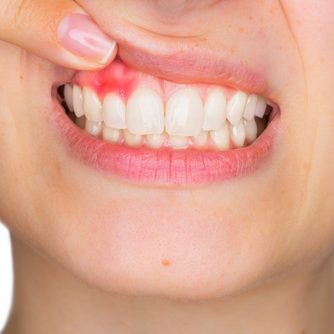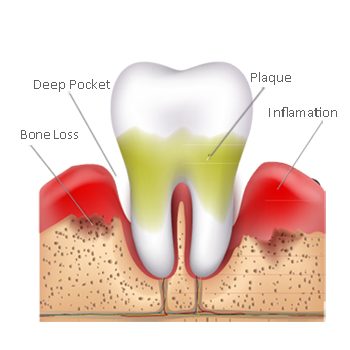Gum Diseases
Gum Disease Treatment
Treatment of periodontal disease varies with the type and severity of the disease. Periodontal disease caused by plaque, gingivitis and periodontitis, make up the majority of periodontal diseases. Gingivitis is the more mild form of the disease and is reversible, Gingivitis may occur without progressing to periodontitis but periodontitis, the irreversible form of the disease, is always preceded by gingivitis.
If you’re suffering from any of these symptoms, see your dentist right away:
- Bleeding, red, swollen, tender gums or gum recession
- Unusual space between teeth
- Frequent bad taste in the mouth
- Loose teeth
Gingivitis
Treatment for periodontitis is more involved as the disease now spread from the gum tissue to the bone and the supporting structures of the teeth. Deeper pockets (more than 4 mm) have been formed around the teeth now causing the attachment of the teeth to the gums to fail, causing the gums to pull away from the teeth, create space and expose the roots. Food gets easily caught in these spaces and being difficult to clean causes tartar to attach to the teeth further aggravating the problem.
Before beginning treatment, Dr. Wadhwa will conduct a thorough examination along with x-rays to evaluate the severity (moderate or advanced), the condition of the gums, amount and location of tartar, inflammation etc. Advanced cases may even require surgery by a Periodontist (specialist) to reduce the depth of gingival pockets, add bone and/or tissue to various areas, and provide solutions to other problems presented by the disease.
Moderate periodontitis involves an initial treatment comprising of scaling, root planning, medicating the gingiva along with periodontal pockets and root surfaces, instructing you in appropriate home care techniques followed by setting up periodic professional periodontal maintenance care visits.
Remember, failure to continue with maintenance after initial therapy can lead to recurrence and worsening of the condition. Periodontal disease cannot be cured, it can only be controlled. The success of your treatment depends largely upon the follow-up at-home and professional care.


Periodontitis
With gingivitis the gum tissue becomes swollen, inflamed, and bleeds during flossing and brushing. Deep pockets (up to 4 mm deep) form around teeth but no loss of bone occurs. Treating gingivitis involves removing the plague, tartar and calculus (calcium deposits) from surfaces above and under the gum line. This is achieved by a professional teeth cleaning procedure after which the patient must ensure dental hygiene by regular brushing, flossing and rinsing at home to prevent any recurrence.
